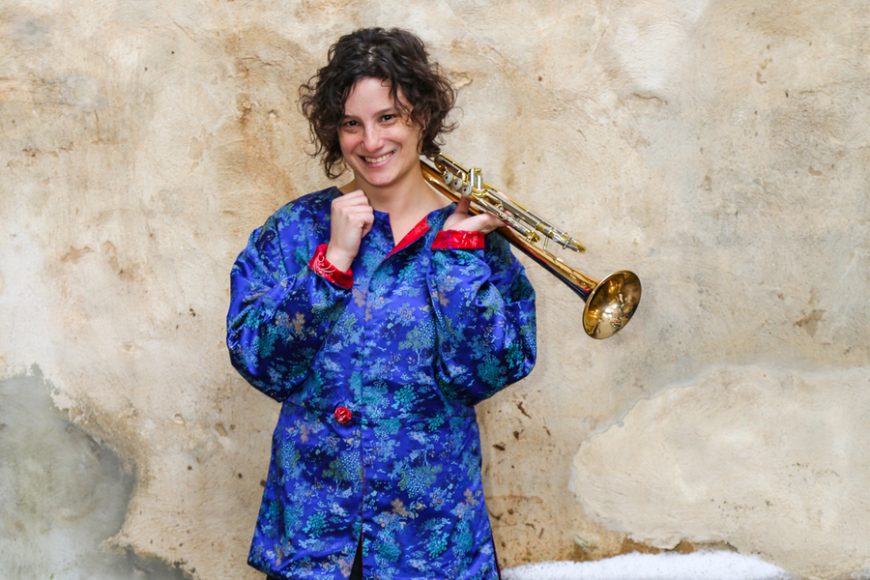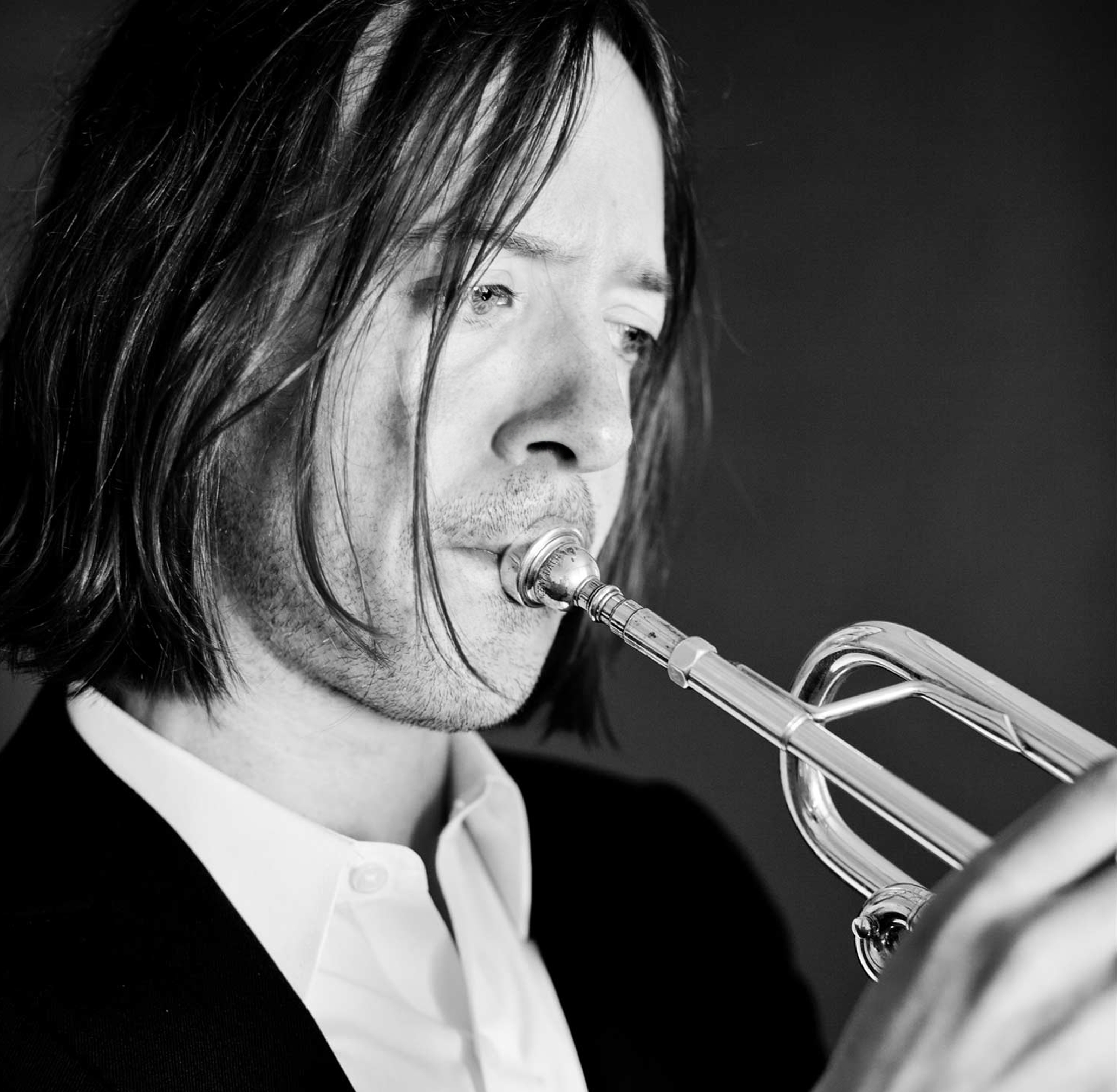Source: http://www.jazzspeaks.org/seismic-belt-samantha-boshnack-speaks
Trumpeter and composer Samantha Boshnack is one of many participating in the upcoming Festival of New Trumpet Music. Boshnack is bringing ‘Seismic Belt’ to the festival, a group performing music about the Ring of Fire, the seismic area located on the rim of the Pacific Ocean. This music, in Boshnack’s own words, “examines our relationship with the Earth, including the elements of risk and faith in that uneasy cohabitation. Movements of the work draw on influences from some of the cultures and people living on the Ring, including Chile, Japan, Alaska, Western Samoa, and Russia.” Over the course of a three-month Make Jazz Fellowship sponsored by the Herb Alpert Foundation in LA, Boshnack composed the work, and its premiere was released as Live in Santa Monica, on Orenda Records in March 2019.
Boshnack also leads and performs with a number of ensembles, and is a fellow at the Gabriela Lena Frank Creative Academy of Music in California. Joining her at The Jazz Gallery for this performance during the Festival of New Trumpet Music will be Chris Credit (tenor/baritone saxophone), Jessica Pavone (violin/viola), Sarah Bernstein (violin), Kai Ono (piano) Lisa Hoppe (upright bass) and Jacob Shandling (drums). We spoke with Boshnack about the new work and her next steps.
The Jazz Gallery: What made you want to use the Pacific Rim and the Ring of Fire as a way of starting a conversation about our relationship with the earth?
Samantha Boshnack: I live in Seattle which is on the Ring of Fire, the horseshoe of volcanic activity around the Pacific. Moving from New York, seeing volcanoes like Rainier and St. Helens, I was immediately floored by their grandeur. Summertime here is a great time to go traveling: I’ve been hiking around mountains in Oregon, I’ve been to Indonesia and Mexico, and always end up trying to get to a volcano. I put out a record in 2014 called Exploding Syndrome that was more focused on Mt. St. Helens–I wrote a suite about that explosion. I felt that there was a lot that could be done with the topic, and I wanted to do two things with it. First, I wanted to explore different cultures living on the Ring of Fire, because there’s so much to look at, including Eskimo music, Russian music, indigenous musics… You’ve got Japan, Chile, the Samoas. Second, I wanted to look at the science of the Ring, and try to portray that musically. We’re living through tumultuous times, and there are things we’ve done to the earth, but there’s an inherent risk of living on earth even without what we’ve done.
TJG: That brings to mind your phrase “Risk and faith in uneasy cohabitation.” So you were looking at music from cultures that live along the Ring of Fire?
SB: Yeah, and I hope to do more. I was interested in finding stories and coping methods from cultures that live on the Ring. I haven’t gotten as deep as I want to yet. It might be a stretch, but I do think people are influenced by where they live, so there must be something of that in the music of their respective cultures. I’m not necessarily saying they all have something in common, but in general, it’s fun to try to be inspired by types of music you’ve never heard. I’ve done a few projects where I was writing for people from different countries, and I liked that way of writing and preparing. Not stealing or even writing ‘in that style,’ but allowing yourself to be inspired by the musicality of another culture. I try to create music that speaks to the experience of dealing with the inherent danger of life, yet also trying to take in the good, the beauty.
TJG: What else has stood out for you in the differences between Atlantic and Pacific coasts? While traveling and research, what other specific things spoke to you?
SB: The idea of the duality of it all. You have these incredibly beautiful mountains that are so dangerous as well. That duality inspires me. When you travel to places in Oregon or Hawaii where there are lava fields or other barren places, it looks like another planet. The lava has burnt the ground and everything on it. It’s beautiful, it’s ugly, it makes you think.
TJG: Is this duality something you’ll talk about with your bandmates while working through this music? Or is it more on your mind while putting notes on the page?
SB: Once the music’s written, I bring it to the musicians and we work it out. They know what it’s about and it comes across, but the composition process is more where I’m tackling the subject matter, and I hope the musicians feel something from it.
TJG: The work was completed at 18th Street Arts Center in LA; What was the residency like for you?
SB: Incredible. It was a tight timeline: You show up at the beginning of February, and the final concert is in the middle of April, with one work-in-progress showing mid-March. It got there. There were no other things I had to do during that time. That’s partly why I wanted to have a topic, because having a specific goal in mind is a great way to delve into a composition project. Something to inspire you while doing work that might otherwise feel overwhelming. Every day, I was listening, researching, writing, and going out and finding the players I wanted to play with for the record. I didn’t know originally that I wanted it to be a record. First, we did the concert, then I got the nice live recording of it, so I released it. The LA jazz scene was great, and I was happy with my collaborators.
TJG: Did you have this Ring of Fire idea before the residency?
SB: Yes, I did apply with that idea. A lot of times, you get these ideas and then apply for things for years. Then something comes through and you get to do it. This is something I’ve been trying to do for a while, so I’m glad it happened [laughs].
TJG: Would you say the music has evolved, changed, grown, shifted as you’ve recorded and continued to perform it?
SB: For sure. Little things. It’s more refined. More instances of “Yeah, we did this on the recording, but maybe we could do it like this instead.” I’ve done this music in LA, Seattle, and one gig at Nublu in July, so this will be the second New York show. The New York players were really great, and of course everyone is different, so it brought a different flavor. There’s lots of improvisation, so that gives a chance for that flavor to come out. It’s different every time.
TJG: What are you looking forward to about this particular iteration at The Jazz Gallery?
SB: The second time is always a great thing. We’ve already rehearsed, we’ve already performed it, so now we can go deeper. You go further every time, of course. All the players are people I respect and admire. I’m honored to be at the Festival of New Trumpet Music, which I’ve dreamed of doing for years. Dave Douglas was a big influence on me starting in college, so I think it’s great that he does this festival.
As a composer, you’re always evolving. Sometimes you listen to your music and you hear elements that have always been there, and yet, they keep shifting and growing with you, your playing, your opportunities, your people. I think that this album is really me, and it feels true to myself. It pays homage to a region, and expresses things I wanted to express.
TJG: Tell me a little about the band that we’ll see at the Gallery.
SB: Chris Credit is flying out with me from Seattle, he plays in my Seattle band. We have Jessica Pavone on viola and viola and Sarah Bernstein on violin. They’re both really accomplished improvisers in New York. Jessica plays a lot with Mary Halvorson, and Sarah has her own great groups. I didn’t know those two string players before I came, but I wrote to Jessica because I’d heard of her and was a fan of her music. We’ll have a younger pianist named Kai Ono, who I actually met doing this string trio composition I’m working on through the Gabriela Lena Frank Academy. He’s in the Academy too, so I asked him to play piano. He sounds great. We’ll have a bassist who lives in New York but is from Germany, Lisa Hoppe. She has a group too and I love her writing. And a drummer named Jacob Shandling, a friend of a friend who brought a lot of excitement to the music on the Nublu gig. The chemistry was great in July, so I decided to keep working with this group.
TJG: What steps are you looking to take in the near future? Say, the next six months, with the band or in general.
SB: With the band, I’m hoping to make more things happen out in New York. I don’t have anything else on the books yet, but I’m trying. Outside of this project, I’m coming back to have my string trio played in Massachusetts. I’m doing a big chamber music writing project over the next year—I’m working with different poets on a topic called ‘Uncomfortable Subjects,’ things people think about but have trouble talking about. I have a lot of work to do on that. So those are my big writing things. I have some dates in Seattle with my quintet too. I play in a group called Alchemy Sound Project that plays on the east coast a lot. I’ll be playing with my mentor and teacher from Bard, Erica Lindsay, who wrote music which was funded by the Chamber Music of America New Jazz Works Grant. We’ll be recording that. The pianist in the group Sumi Tonooka also got the grant, so I’ll be playing with her too. So I’ll be out on the east coast a lot doing other people’s music, and then booking my own when I can. Sometimes you have things booked way out in advance, then other times things come together quickly and suddenly.
by Noah Fishman, The Jazz Gallery


